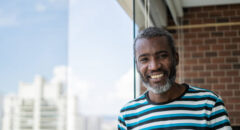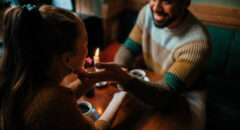
In 2002, I had just landed a dream job that combined my love of learning with college students and a grounding in how faith shapes who we are, how we understand life and the world around us, as well as how we prioritize based upon those factors and understandings. I was already struggling with uncertainty and no small amount of self-doubt and fear because I was the the youngest member of the faculty, the newest, the only one without a PhD, and the only Black person outside of the chef who prepared meals for the students.
READ: #BlackGirlHealing: “I Have Been Afraid That Stress Will Kill Me”

Although there had been some indications that my body and mind were struggling—the sense of being overwhelmed and tired no matter how much rest I got; the cramp in my leg that developed as I stepped off a stair, lasted for a week, and that left a bruise that lasted another two weeks—it wasn’t until a Wednesday that fall (late September/early October) that I grew concerned because there was a “hole” in my vision; a place in which no matter where I looked, no matter how many drops I used, or how much I cleaned my glasses, nothing was visible.
Because my maternal grandmother had had diabetes, and because I was quite obese, my mind first conjured up ideas that perhaps it was a detached retina that had developed due to an undiagnosed case of diabetes. I was able to make an appointment with an ophthalmologist that same day, which meant I would need to leave class early. Despite how I thought that would make me look—to my colleagues and to the students—I was just frightened enough to leave for the appointment anyway.
During that visit, the doctor took me through a battery of exams, all of which confirmed that there was as an extensive area in the field of vision in my left eye that was basically a blank spot. Perplexed, the doctor made an emergency appointment for me with, in his words, “the ophthalmologist other ophthalmologists send patients to when we cannot figure out how to handle the case.” So, I went home that day knowing that something was wrong, but at least it wasn’t a detached retina, so I was relieved.
I learned that the loss of vision was due to something called optic neuritis (or inflammation of the optic nerve), and that based upon this diagnosis I likely had multiple sclerosis (MS) and should go to see a neurologist at the first opportunity available.
READ: Foods To Avoid With Multiple Sclerosis
Ten days of more tests confirmed I had MS, and that the disease had been active for quite some time. Looking back, it was easy enough to see how everything had been pointing to this diagnosis.
I still get a chuckle out of the fact that my response to the diagnosis was that Black people don’t get MS, because even though I’d been cautioned not to look up anything about the disease (due to a great deal of misinformation about causes, treatments, cures, etc.) until I’d gotten a definitive diagnosis, I was an educator with no small amount of curiosity, two computers, access to journals, and Internet search skills. Nowhere in my explorations did I find Black people, and indeed I’d read that those of African descent were unlikely to be diagnosed with the disease. So, I was left with images of Annette Funicello and the mother of a high school friend, who’d been bedridden for well over a decade…neither of which I was willing to accept as indicative of my fate.
Weathering the MS Storm
 To say that I was overwhelmed would be an understatement. I’d withheld information from my family until I was officially diagnosed, and now I had to figure out how to tell them, how to learn as much as I could about this disease, and how to comprehend what all of this meant personally, professionally, and financially.
To say that I was overwhelmed would be an understatement. I’d withheld information from my family until I was officially diagnosed, and now I had to figure out how to tell them, how to learn as much as I could about this disease, and how to comprehend what all of this meant personally, professionally, and financially.
My daughter was only 11 at the time, and I was the sole breadwinner for my family, including my mother, so I was reluctant to “give in” to the disease or any indication of infirmity. I kept up my same busy schedule, and worked even harder to ensure that I did not show any signs of weakness.
Together we’ve weathered the MS storms: fatigue so severe I’ve slept for days at a time, stirring only to use the restroom or get a drink of water; pain that existed, but did not respond to OTC analgesics; spasticity that caused my body to contort to unusual and awkward positions, or muscles to contract for hours, days, and weeks at a time; balance challenges that saw me move from “drunk walking” to “wall walking” to one cane, then two canes, and finally a rolling walker; a slowing of my cognitive processing speeds; leaving my job on disability as the disease became too much to navigate while continuing to work; a depression that deepened as I no longer had a sense of purpose, meaning, and value that can be byproducts of gainful employment; and finally gaining over 100 lbs over two years as a result of all of these things and reduced mobility.
Although I never would have described it as such initially, MS has proven to be a blessing in disguise, because it’s given me something against which to fight every day. Once I decided that I couldn’t live as I had been—self-imposed isolation as a result of having gained so much weight (I weighed 364 lbs at my largest recorded weight); self consciousness about the slowed cognitive processing speeds, which made engaging in conversation challenging, as I couldn’t keep up with all of the ideas and background noises proved to be more distracting than they had ever been—I set out on a path to reclaim power over these areas. This path has led to much better physical health outcomes overall, and helped to combat the social and emotional toll that disability in the prime of my life brought about.
Learning to Go the Distance
In the fall of 2012—one decade after my initial MS diagnosis—I met one of the co-founders of GirlTrek, who shared the mission of the organization with such enthusiasm and so much encouragement that I made the commitment to walk 30 minutes a day, at least 5 days a week. Before this, walking was something that I did intentionally only for WalkMS, the annual fundraising event sponsored by the National MS Society. The outcome for each walk was the same: increased spasticity, pain, and fatigue, but it was such a joy for me to participate in something that was actually proving to be beneficial in combating MS, and alongside others who knew what I was going through and living with. Yet, here I was, taking a public stance to walk regularly and consistently.
Those first walks were a struggle, and I didn’t get far in those 30 minutes, but I kept at it. Eventually, I could go farther and farther in 30 minutes, and then I began to set distance challenges, because I enjoyed seeing what my body could do. The regular exercise gave me greater strength physically, but also mentally, emotionally, and spiritually. As I shed even more weight, it became easier to move, and I have become obsessed with seeing how I can continue to move or learn to move in new ways. As of today, I’ve completed numerous 5K and 10K races, and I’m preparing for my 9th half marathon in June. I’ve even completed the 50K ChallengeWalkMS, and hiked a mountain in Rocky Mountain National Park.

Would I have done all (any?) of this without an MS diagnosis? I don’t know. What I do know, though, is that too often I took my body and my life’s circumstances for granted, and assumed everything would always work…until it didn’t. So, while MS can impose challenges, it’s the ones I impose upon myself that I am learning to overcome.
There is no cure for MS…yet…and the disease modifying therapies don’t eliminate the disease, the symptoms, or help restore functionality, and those are difficult concepts to understand, especially since advertisements for medications appear in television, radio, and print, and all claim to offer solutions to whatever it is that challenges us. I’ve learned, however, that although they play a role in helping to keep me well, the role I play is a much larger piece of the equation: What I eat (or don’t); how much I move (or don’t); how social and engaged I am (or not); how I advocate for my needs and those of the MS community; and how informed I remain about advances in MS research (or not).
Once I re-engaged my tenacity (that’s stubbornness in formal attire), I realized that MS is part of me, but it is not the sum total—or even the most important aspect—of who I am. I’ve had to find new ways to tap into what brings joy and a sense of purpose, but being able to step back and to reinvent who I am and who I want to be is a gift that MS has given me, and one I won’t be returning, even when we find a cure.

Do you have a health testimony to share? Email your story to [email protected].








